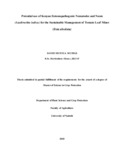| dc.description.abstract | The tomato leaf miner, Tuta absoluta (Meyrick) (Lepidoptera: Gelechiidae) was reported in
Kenya in 2014 and has become a devastating pest of tomato crop in both the field and in the greenhouse. The objectives of this study were; to determine the pathogenicity of Heterorhabdities species and Steinernema karii nematodes against tomato leaf miner in laboratory conditions; to evaluate the insecticidal effects of neem biopesticide against tomato leaf miner in the greenhouse and to evaluate the effectiveness of entomopathogenic nematodes and neem combined with entomopathogenic nematodes as management options for tomato leaf miner in the greenhouse conditions. Entomopathogenic nematodes (EPNs) used in the study were obtained from Kenya Agricultural and Livestock Research Organization (KALRO) entomopathogenic nematodes laboratories and Tuta absoluta larvae were obtained from a colony reared and maintained in a greenhouse at Kabete Campus Field Station, Nairobi. Multiplication of the EPNs was done by in-vivo method or the insect-bait technique with the third instar of greater wax moth (Galleria mellonella). Bioassays were conducted in petri dishes where the effects of EPNs concentrations; at 100, 300and 500Ijs/ml on Tuta absoluta larvae exposed for 24-72 hours were evaluated. Secondly, three different concentrations namely; 20ml/20L, 40ml/20L and 60ml/20L of Nimbecidine® (Azadirachtin) were evaluated against Tuta absoluta populations in the greenhouse. Thirdly, the following management options; Steinernema karii nematodes alone applied at a rate of 1000 Ijs/ml with oil adjuvant Addit® as a wetting agent in water, Steinernema karii nematodes and neem (Azadirachtin 0.03%) applied sequentially after one hour at a rate of 40ml/20L were evaluated against Tuta absoluta populations. These were compared with Coragen® SC (20% Chlorantraniliprole) synthetic pesticide applied at the rate of 3ml/20L and control where only water was applied. A delta sticky trap supplied with Tuta absoluta pheromone was hanged at the centre
xiii
of the greenhouse at a height of one metre for monitoring Tuta absoluta numbers to enable the initiation of treatments. The results obtained showed that, the evaluated concentration rates of Heterorhabditis species and Steinernema karii at 100Ijs/ml, 300 Ijs/ml and 500 Ijs/ml significantly caused (p < 0.05) mortality to the Tuta absoluta larvae and the highest mortality was recorded at 500 Ijs/ml concentrations with an exposure period of 72 hours. Steinernema karii was more pathogenic compared to Heterorhabditis species with respect to exposure time, having shown 100% and 91.5% larval mortality, respectively. Secondly, the evaluated neem concentrations 20ml/20L, 40ml/20L and 60ml/20L significantly (p < 0.05) reduced Tuta absoluta population in the greenhouse tomato. The high concentration (60ml/20L) was more effective in reducing Tuta absoluta population and fruit damage compared to the lower concentrations and control. High fruit damage of 96.2% was recorded in the control compared to 30.0%, 23.4% and 20.0% for 20ml/20L, 40ml/20L and 60ml/20L dose rates, respectively. Lastly, EPNs alone and EPNs combined with neem significantly (p < 0.05) reduced the population of Tuta absoluta. The number reduction of Tuta absolutaby EPNs combined with neem did not differ with that which was achieved in Coragen®. Tomato fruit damage was highest in the control with 91.5% compared to 10.8%, 7.9% and 3.0% for EPNs alone, EPNs combined with neem and Coragen®, respectively. This study demonstrates the potential of EPNs alone or in combination with neem applied successively at a one hour interval, as an alternative strategy for the sustainable management of Tuta absoluta in the greenhouse conditions. | en_US |

